
The Adhola people, also known as Jopadhola, are a Nilotic ethnic group of Luo peoples that live in Tororo District of Eastern Uganda and comprise about eight percent of the country's total population. They speak Dhopadhola,, which belongs to the Western Nilotic branch of the Nilotic language family. They are primarily pastoralists. The Jopadhola call their land Padhola which, according to historian Bethwell Ogot, is an elliptic form of "Pa Adhola" meaning the "place of Adhola", the founding father of the Jopadhola people. Officially, land of the Adhola is called Padhola, but the Baganda who misinterpret 'Widoma' – a Dhopadhola word for 'war cry' meaning 'You are in trouble' refer to the Jopadhola as "Badama". The social structure of the Jopadhola can be described as semi centralised because there is no traditional centralized government and its organization is limited to a clan called Nono. There are over 52 clans, each with cultural practices, common ancestry and a distinct lineage.

Okot p'Bitek was a Ugandan poet, who achieved wide international recognition for Song of Lawino, a long poem dealing with the tribulations of a rural African wife whose husband has taken up urban life and wishes everything to be westernised. Song of Lawino was originally written in the Acholi dialect of Southern Luo, translated by the author into English, and published in 1966. It was a breakthrough work, creating an audience among anglophone Africans for direct, topical poetry in English; and incorporating traditional attitudes and thinking in an accessible yet faithful literary vehicle. It was followed by the Song of Ocol (1970), the husband's reply.

Culture of Uganda is made up of a diverse range of ethnic groups. Lake Kyoga forms the northern boundary for the Bantu-speaking people, who dominate much of East, Central, and Southern Africa. In Uganda, they include the Baganda and several other tribes

African dance refers to the various dance styles of sub-Saharan Africa. These dances are closely connected with the traditional rhythms and music traditions of the region. Music and dancing is an integral part of many traditional African societies. Songs and dances facilitate teaching and promoting social values, celebrating special events and major life milestones, performing oral history and other recitations, and spiritual experiences. African dance uses the concepts of polyrhythm and total body articulation. African dances are a collective activity performed in large groups, with significant interaction between dancers and onlookers in the majority of styles.

Ngoma are musical instruments used by certain Bantu populations of Africa. Ngoma is derived from the Kongo word for "drum". Different Bantu-inhabited regions have their own traditions of percussion, with different names for their instruments. In Kikongo, "ngoma" is used by extension to signify specific dances, social occasions, and rhythms. In Swahili, Ngoma music is used to describe music, dance, instruments including the drums, and events together as a joint cultural practice.
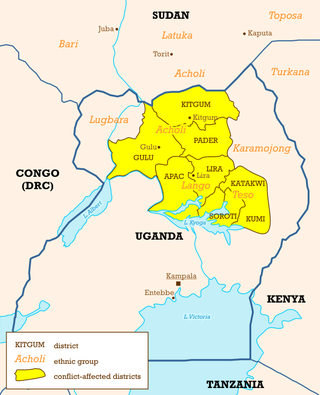
The start of the period 1994 to 2002 of the Lord's Resistance Army insurgency in northern Uganda saw the conflict intensifying due to Sudanese support to the rebels. There was a peak of bloodshed in the mid-1990s and then a gradual subsiding of the conflict. Violence was renewed beginning with the offensive by the Uganda People's Defence Force in 2002.
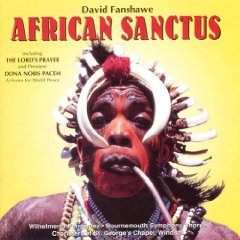
African Sanctus is a 1972 choral Mass and is the best-known work of British composer and collector of world musics David Fanshawe.

The Uganda Museum is located in Kampala, Uganda. It displays and exhibits ethnological, natural-historical and traditional life collections of Uganda's cultural heritage. It was founded in 1908, after Governor George Wilson called for "all articles of interest" on Uganda to be procured. Among the collections in the Uganda Museum are playable musical instruments, hunting equipment, weaponry, archaeology and entomology.
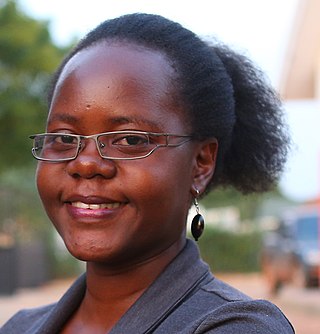
Ber Anena born and previously published as Harriet Anena is a Ugandan writer and performer, whose writing includes poetry, nonfiction and fiction. She is the author of a collection of poems, A Nation In Labour, published in 2015, won the 2018 Wole Soyinka Prize for Literature in Africa. The Economist described her poetry performance as "an arresting evocation of love and war".

The Acholi people are a Nilotic ethnic group of Luo peoples, found in Magwi County in South Sudan and Northern Uganda, including the districts of Agago, Amuru, Gulu, Kitgum, Nwoya, Lamwo, Pader and Omoro District. The Acholi were estimated to number 2.3 million people and over 45,000 more were living in South Sudan in 2000.

Larakaraka is a traditional courtship dance that originated from the Acholi people of Uganda. This dance, among the more than 50 Acholi dances, holds significant importance and is typically performed on special occasions, particularly weddings. Serving as a romantic display of artistry and physical prowess, Larakaraka enables young men to exhibit their dancing skills, vitality, and agility, all with the intention of attracting a potential life partner.
The Otole is a traditional war dance of the Acholi people. Its purpose is to teach young Acholi what to expect during combat. Participants include men and strong women aged 30-50 years.
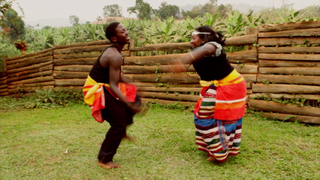
Ekitaguriro aka Cow Dance is a traditional dance originating from Nkore or Ankole region which is located in the South Western Uganda. It is a celebratory dance that is performed by both men and women as an expression of gratitude for their cattle and to showcase local prosperity such as birth, marriage and abundant harvest. It is an integral part of social gatherings and events in the region, symbolizing the deep-rooted cultural significance of cattle in the community.

Bwola, also known as Acholi bwola, is a traditional dance that originates from the Acholi people in Northern Uganda. It is reserved for special occasions and performances in front of royalty, including kings and chiefs. This dance is often showcased during the installation of new chiefs or at various royal functions.
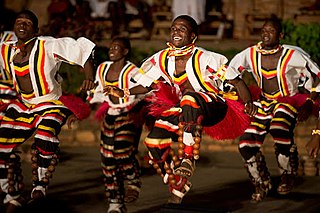
Entogoro, also known as Orunyege, is a traditional courtship dance that is performed by the Batooro people of western Uganda. The dance holds great significance in the Tooro culture, practiced by young adults to select potential partners for marriage, as well as during weddings, initiation ceremonies, and social gatherings. Its name comes from the ebinyege rattles and entogoro rings associated with the dance.

Orunyege-Ntogoro is a traditional dance from the Bunyoro and Tooro kingdoms in western Uganda. It is a courtship dance that involves the use of rattles (ebinyege) and rings (entogoro) to produce rhythmic sounds and movements. The dance is performed by young men and women who seek to attract and impress potential partners for marriage.

Bakisimba dance (Baakisiimba) also known as Nankasa or Muwogola is a traditional dance form originating from the Baganda people of Buganda Kingdom in Central Uganda. It is believed to have originated from the movements of a drunken King Ssuuna of Buganda Kingdom. The dance was initially performed in the Buganda Royal Court in ancient times an it holds significant cultural and social importance within the community and is often performed during tribal ceremonies, celebrations, and festive occasions.

Akogo dance is a traditional dance form of the Teso people of Eastern Uganda. This cultural expression is performed by both men and women, who gracefully move their bodies in synchrony with the rhythmic beats of the akogo, a percussion instrument crafted from bamboo tubes of varying lengths. The Dance is believed to have been performed by the Teso people for centuries and has evolved over time and has been influenced by other dance forms from neighboring regions.

Amaggunju is a traditional folk dance of the Baganda, who represent the largest ethnic community in Uganda. This royal dance is performed during important occasions such as coronations, weddings, and other cultural events. Notable features of the dance are its distinct rhythmic drumming and energetic movements, executed by both male and female performers.

Calabash is a traditional plant locally grown in many parts of Uganda. Its a non-food plant that produces several fruits of different sizes. The biological name of this plant is Lagenaria siceraria. Once harvested, its left to dry and is mainly used for traditional purpurses like dancing during traditional weddings, crafted as musical instruments by some tribes in their traditional dances for example the Bigwala, Baganda, Acholi, preserving milk, harvesting milk cream, and also used by traditional healers. Calabash is a symbolic cultural item that many Ugandan tribes use for different purposes.






















